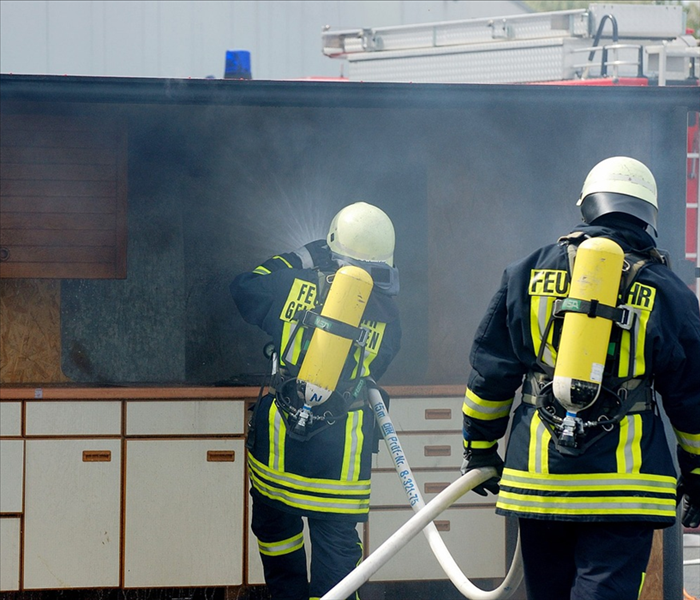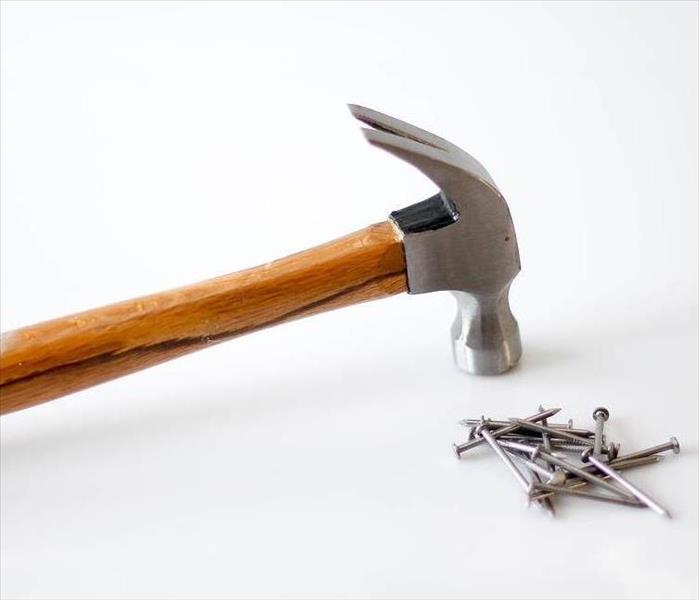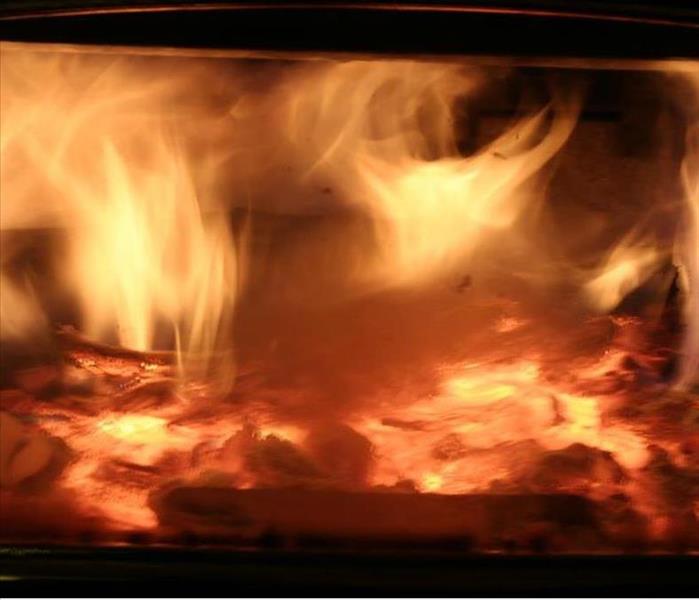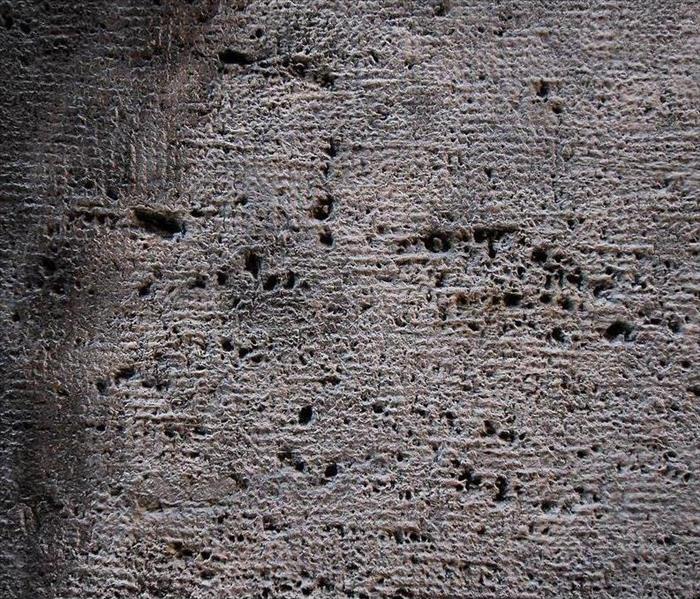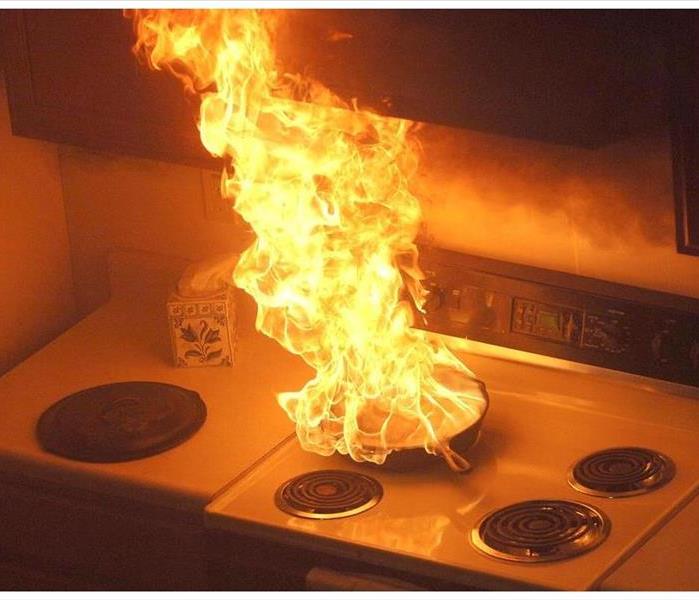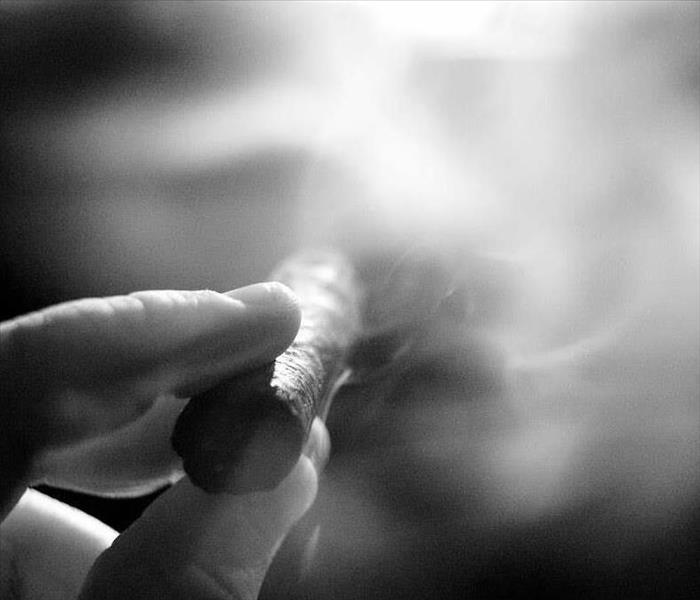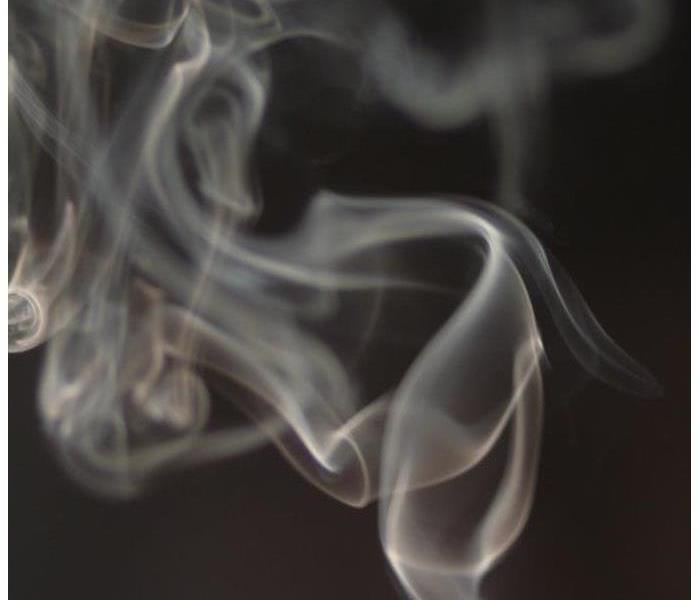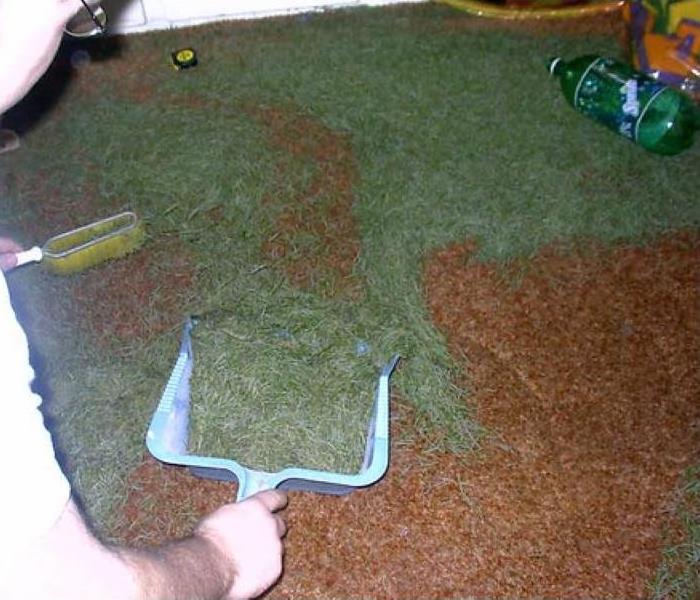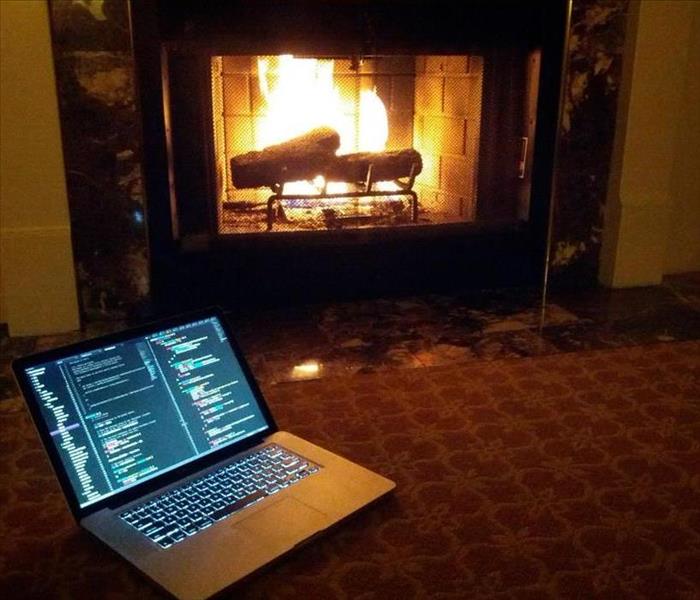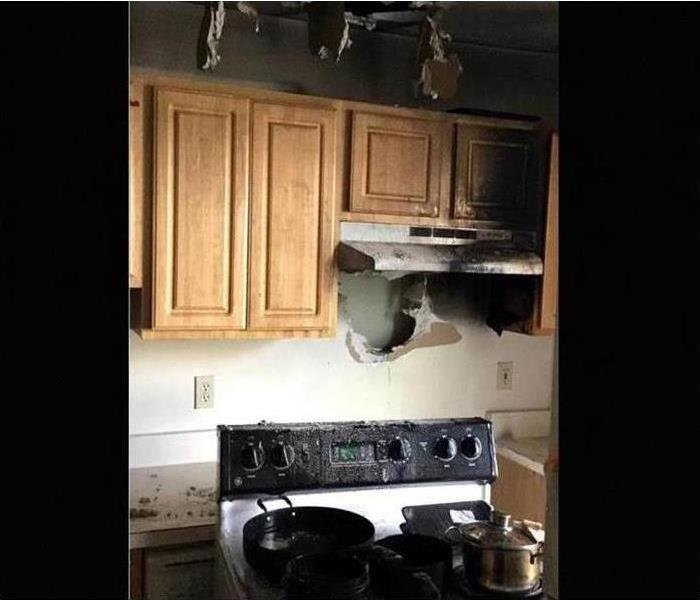Recent Fire Damage Posts
Extinguishing a Kitchen Fire
8/22/2023 (Permalink)
When a fire starts in the kitchen, you need to act fast to keep the fire from getting out of control. But how you act depends on what kind of fire you have and where it is. Follow these instructions for putting out kitchen fires:
If you have a fire in the oven or the microwave, close the door or keep it closed, and turn off the oven. Don’t open the door! The lack of oxygen will suffocate the flames. If your oven continues to smoke like a fire is still going on in there, call the fire department. If you have a fire in a cooking pan, use an oven mitt to clap on the lid, then move the pan off the burner, and turn off the stove. The lack of oxygen will stop the flames in a pot.
If you can’t safely put the lid on a flaming pan or you don’t have a lid for the pan, use your fire extinguisher. Aim at the base of the fire — not the flames. Never use water to put out grease fires! Water repels grease and can spread the fire by splattering the grease. Instead, try one of these methods:
If the fire is small, cover the pan with a lid and turn off the burner. Throw lots of baking soda or salt on it. Never use flour, which can explode or make the fire worse. Smother the fire with a wet towel or other large wet cloth.
Use a fire extinguisher. Don’t swat at a fire with a towel, apron, or other clothing. You’re likely to fan the flames and spread the fire. If the fire is spreading and you can’t control it, get everyone out of the house and call 911! Make sure everybody in your family knows how to get out of the house safely in case of a fire. Practice your fire escape route.
What you don't know about Lightning
8/30/2022 (Permalink)
Lightning fires most commonly occur during the summer months when afternoon and early evening storms are at their peak. Homes in heavily wooded areas are extra vulnerable to lightning strikes that set the surrounding landscape on fire. Most people might already know this but do they know what to do to help their home could be as easy as installing a lightening rod or the professional term would be a lightning protection system.
These systems are not intended to prevent a strike. Its purpose is to provide a safe path on which the current can be safely directed to the ground. Talk with an expert and find out if you should have a system on your house.
You will also want to help protect the inside of your house during a storm. Lightning can damage the electronics, telephone and other systems in your house connected to an electrical outlet. The easiest way to protect your appliances is to unplug them when you first hear the clap of thunder.
Surge protectors can help but are not fail-proof if the strike is a powerful one. To protect yourself, stay away from all plumbing including toilets, sinks and faucets as the pipes of your house make excellent conductors. Stay off the phone , corded phone scan conduct the lightening and therefore strike you when your on the phone.
Lightening is amazing and beautiful but also deadly. Don't ever let yourself forget that.
Restoring After a Fire
8/30/2022 (Permalink)
When you have a fire it can be devastating. Most of the time the hard part is loosing so much of your contents. When you have fire damage, you also have soot, odor and water damage.
We at SERVPRO of Carroll County want to help restore as much as we can for you. We have specialized training in doing just that.
First we do an inspection and fire damage assessment to begin to form a plan of action.
If needed, we will immediately properly board up your home and a roof tarp.
The water removal will begin immediately as well as the drying.
We have specialized equipment and techniques to remove smoke and soot from ceilings, walls and other surfaces.
We will clean, disinfect, and sanitize all of the restorable items.
Finally, SERVPRO of Carroll County County can even help you with the restoration and rebuild process. We are a one stop shop with our construction team!
Lingering Fire Smell
8/30/2022 (Permalink)
Have you ever noticed how when you burn a bag of popcorn in the microwave the smell seems to linger for way longer than it should?
That's what happens with even the smallest fire in your home or business. After a fire if the area isn't properly cleaned, restored, and deodorized the burnt scent can hold onto to your space for years to come. The smoke from a fire is what carries the awful scent throughout a structure. This smoke sets into any surface it can touch.
If a cleanup isn't executed as fast as possible, the residue can cause permanent damage and could even cause the smell to come back!
The SERVPRO of Carroll County team is highly trained to locate and remove the source of the odor. Other professionals will just mask the scent with a fragrance of some kind and once it wears off, you're left with the bill and no actual solution to your odor problem.
Our professionals also work to make sure you understand your possible options when it comes to deodorization.
Soot is Small, VERY Small!
8/30/2022 (Permalink)
Soot is small. And we mean VERY small. In fact, one particle of soot is typically 2.5 micrometers or smaller, try imagining that! After a fire burns in an area, those teeny tiny soot particles float all over the place and spread burnt carbon, wood, oil, dirt, etc. in every nook and cranny that you didn’t even know existed.
Soot is so tiny that it doesn’t just cover the surface of everything in your space, it also gets INSIDE of almost everything. Your cabinets, drawers, air ducts, it can even make its way into the airtight sealed doors of refrigerators! How crazy is that?
When you have a fire in your home, you need a local team of highly trained professionals to come and clean all of those microscopic soot particles out of your space. You don’t want an unsanitary space that smells like burnt carbon, and neither do we! Give us a call and we will be there right away, we’re open 24/7!
Too hot in the Kitchen!
8/8/2022 (Permalink)
Although house fires are generally down in numbers during the summer months, you still need to be on your toes when cooking. Cooking accidents are one of the top leading causes of house fires. Grease and oils can ignite an unattended stove and cause a fire to spread all throughout your home! Another way that a fire can occur is with dish towels or other things being left on or near the stove. These items can ignite easily and consequently spread to other nearby items or surfaces.
Taking the cooking outdoors in the summer doesn't necessarily keep you safe from a cooking fire. Mishandled propane tanks are responsible for many fires and injuries.
Summertime is a time to be careful as always whether you are cooking indoors or outdoors. Enjoy the easy breezy days of summer but stay on your toes when cooking.
If you have any sort of fire disaster occur in your home, SERVPRO of Carroll County is always here to help!
What's That Smell?
6/27/2022 (Permalink)
Have you ever noticed how when you burn a bag of popcorn in the microwave the smell seems to linger for way longer than it should?
That's what happens with even the smallest fire in your home or business. After a fire if the area isn't properly cleaned, restored, and deodorized the burnt scent can hold onto to your space for years to come. The smoke from a fire is what carries the awful scent throughout a structure. This smoke sets into any surface it can touch.
If a cleanup isn't executed as fast as possible, the residue can cause permanent damage and could even cause the smell to come back!
The SERVPRO of Carroll County team is highly trained to locate and remove the source of the odor. Other professionals will just mask the scent with a fragrance of some kind and once it wears off, you're left with the bill and no actual solution to your odor problem.
Our professionals also work to make sure you understand your possible options when it comes to deodorization.
We make it "Like it never even happened."
Facts about Fireworks
8/30/2021 (Permalink)
There is a joke about buying Fireworks that comes out in the summer. It goes something like this: "always buy from the guy missing a few fingers, you know he always has the good ones!"
Kind of funny, but not so much if it happens to you!
Every year, people around the US get injuries from fireworks. Some lose a finger, some lose their home to fire and some even worse.
It's not hard to believe that some people call the 4th of July the deadliest of holidays!
If you're going to enjoy setting off fireworks this year at anytime, follow the instructions on the firework as well as these few tips:
Have a bucket of water near by
Light one at a time
Don't try to re-light a "dud" firework. Give it some time and then soak it in water
Wear safety glasses
Don't let children handle fireworks
Always be a safe distance from any buildings or cars
Dispose of spent fireworks by wetting and then tossing in a metal trash can
The last thing to remember is to pack your common sense this summer and anytime you light off fireworks, check your surrounds and look for things that could go wrong.
You don't want to be like the guy in joke!
The Different Types of Smoke
8/30/2021 (Permalink)
Fire losses and the damage they leave behind can be an incredibly complex job to deal with. This is caused largely by the behavior of smoke. When our SERVPRO professionals respond to a call for a fire job, their initial goal is to determine the extent of damage from fire itself, smoke, heat, and moisture. Not only do we deal with damage to building structures, but we work to clean buildings contents.
Our SERVPRO trained professionals are trained to understand how smoke penetrates various cavities within the structure, causing hidden damage and odor. Our teams knowledge helps them investigate how far smoke damage may have spread. We know it can be stressful when you don't understand the issues facing your home, so take a moment to read up on the different kinds of smoke and soot that could potentially effect your property.
While there are technically only two different types of smoke - wet and dry, there are varying types of soot residue after a fire. Here's a handy glossary of smoke and soot types that might come in handy if you're ever faced with the misfortune of dealing with a property fire:
Wet smoke (plastic & rubber): Low heat, smoldering, pungent odor, sticky, smeary. These smoke webs are more difficult to clean.
Dry smoke (paper & wood): Fast burning, high temperatures, heat rises and thus so does the smoke
Protein fire residue (caused by evaporation of material instead of fire): Virtually invisible discolors paints and varnishes, extremely pungent odor
Fuel oil soot (furnace puff backs): While "puff backs" can create havoc for homeowners, SERVPRO can, in most cases, restore your contents and your Baltimore structure quickly (thanks to their training)
Additionally, we do deal with tear gas, fingerprint powder, and fire extinguisher resides. These special situations require special care and evaluation.
Understanding and having the ability to differentiate between these different types of smoke and soot is part of SERVPRO's specific training which makes us a cut above any other local restoration team. Trusting a company to care about your home like you do can seem daunting and feel impossible, but when it comes to SERVPRO, you can trust you are in good hands at SERVPRO of Carroll County. We make it, "Like it never even happened."
Fire Do's and Don'ts
8/29/2021 (Permalink)
Fire damage itself is enough trouble as is, but most forget that smoke damage and other odors can be just as much of a nuisance. After a fire, it's important to act appropriately in order to avoid secondary damage. These do's and don'ts might come in handy to help you increase chances of a successful restoration.
DO:
- Limit movement. Extensive movement can further embed soot particles in your carpet and other upholstered surfaces
- Keep you hands clean so you don't transfer any soot around and damage walls and woodwork, etc.
- Put dry, colorfast towels and/or old linens on rugs, upholstery and carpet traffic areas
- If your electricity has failed, empty any fridges and freezer entirely. Then prop their doors open to prevent odor
- If you have chrome appliances or trim, you can wipe soot from those surfaces and apply a thin coating of lubricant to them
- If you fire occurs during winter and your heat fails, pour RV antifreeze into sinks, toilet bowls, holding tanks, and tubs to ensure your pipes and other fixtures don't freeze
- Change your HVAC filters, but leave the system off until it is checked by a professional
- Tape double layers of cheesecloth over your air registers. This keeps soot particles out of your HVAC system
DON'T:
- Don't try to wash any walls or painted surfaces without calling SERVPRO of Carroll County to consult about the extent of the damage
- Don't shampoo carpet of upholstered furniture
- Don't try to clean any electrical appliances that might have been close to the flames, heat, or water, because they might have become contaminated
- If your ceiling is wet, do not turn on the fan. The wiring might be wet or damaged and could cause electrical shock. Air movement could also spread around other particles and cause secondary damage
- Don't send your garments to the dry cleaner, as improper cleaning might only set in the smoke odor
If your home or business is faced with fire damage, don't try to clean it yourself. Our SERVPRO professionals are given special training and specific equipment to mitigate fire damage without furthering damage.
The Fire Remediation Process
8/29/2021 (Permalink)
When you have a fire, it can be devastating. The most difficult part of having a fire in your home or business is losing your precious belongings. When a fire occurs in your space, it typically comes along with soot, odor, and other water damage.
We at SERVPRO of Carroll County want to help restore as much as we can for you. Our professional team has specialized training in doing just that.
First, we do an inspection and fire damage assessment to begin to form a plan of action, customized especially for your individual space. If necessary, we will properly board up your home and put up a roof tarp.
The water removal will begin immediately as well as the drying.
We have specialized equipment and techniques to remove smoke and soot from ceilings, walls and other surfaces. We will clean, disinfect, and sanitize all of the restorable items.
Finally, SERVPRO of Carroll County can even help you with the construction process after remediation is done. Our Rebuild Division has the tools you need to get your place back in tip top shape!
Cleaning up After a Fire
8/10/2021 (Permalink)
You had a fire in your home, but before it got too out of control, SERVPRO was able to put it out; thank goodness! You're so glad that the disaster was mitigated quickly and efficiently, but all of a sudden, it hits you... your home is a MESS!
You now may have water damage, fire extinguisher damage, odor damage, soot damage, just to name a few.
SERVPRO of Carroll County is here to help figure out exactly how to clean what and with what method.
We provide you with Dry Cleaning Services, Wet Cleaning, Spray and Wipe, Foam Cleaning, Abrasive Cleaning, Immersion Cleaning to name some.
If you have valuable documents, SERVPRO might use alternative methods such as Air Drying, Dehumidification, Freeze Drying, Vacuum Freeze Drying or Vacuum Thermal Drying.
SERVPRO can coordinate with your Electronic Clean up. Believe it or not, some or all of your electronics can be restored!
So to answer the question...Yes, there is more than one way to clean your items after a fire.
The Lingering Smell
6/28/2021 (Permalink)
Have you ever noticed how when you burn a bag of popcorn in the microwave the smell seems to linger for way longer than it should?
That's what happens with even the smallest fire in your home or business. After a fire if the area isn't properly cleaned, restored, and deodorized the burnt scent can hold onto to your space for years to come. The smoke from a fire is what carries the awful scent throughout a structure. This smoke sets into any surface it can touch.
If a cleanup isn't executed as fast as possible, the residue can cause permanent damage and could even cause the smell to come back!
The SERVPRO of Carroll County team is highly trained to locate and remove the source of the odor. Other professionals will just mask the scent with a fragrance of some kind and once it wears off, you're left with the bill and no actual solution to your odor problem.
Our professionals also work to make sure you understand all of your possible options when it comes to deodorization.
Fire from the Dryer!
6/28/2021 (Permalink)
According to FEMA, failing to clean your home dryer causes 34% of home dryer fires.
These dryer fires cause $35 million in property loss and are also capable of causing injury or even death.
Reducing your risk for dryer fire is incredibly simple. Let SERVPRO clean your vents and ducts that may being holding lint buildup.
The National Fire Protection Agency recommends that you clean your dryers lint filter every time you do a load of laundry. This ensures the outdoor vent flap will open with ease. This flap could be restricted by snow or even a bird's nest.
Let our specifically trained technicians make sure all of your vents, filters, and ducts aren't restricted and can let air flow freely.
For more info about the vent and duct cleaning services SERVPRO of Carroll County offers, give us a call at (410) 857-5332.
Extinguishing a kitchen fire
9/2/2020 (Permalink)
If a fire starts in the kitchen, you need to act quickly to keep the fire from getting out of control. But how you proceed depends on what kind of fire you have and where it is. Follow these instructions for putting out kitchen fires:
If you have a fire in the oven or the microwave, close the door or keep it closed, and turn off the oven. Don’t open the door! The lack of oxygen will suffocate the flames. If your oven continues to smoke like a fire is still going on in there, call 911. If you have a fire in a frying pan, use an oven mitt to clap on the lid, then move the pan off the burner, and turn off the stove. The lack of oxygen will stop the flames in a pot.
If you can’t safely put the lid on a flaming pan or you don’t have a lid for the pan, use your fire extinguisher. Aim at the base of the fire — not the flames. Never use water to put out grease fires! Water repels grease and can spread the fire by splattering the grease. Instead, try one of these methods:
If the fire is small, cover the pan with a lid and turn off the burner. Throw lots of baking soda or salt on it. Never use flour, which can explode or make the fire worse. Smother the fire with a wet towel or other large wet cloth.
Use a fire extinguisher, don’t swat at a fire with a towel, apron, or other clothing. You’re likely to fan the flames and spread the fire. If the fire is spreading and you can’t control it, get everyone out of the house and call 911! Make sure everybody in your family knows how to get out of the house safely in case of a fire. Practice your fire escape plan.
Protein Fire
9/2/2020 (Permalink)
You have dinner cooking and the phone rang, then you had visitors knocking on your door and lost track of time. An hour or two later you realize the food you have been cooking is now a charred clump of chicken or roast with a pot of burnt chili – with a distinct, overwhelming rancid smell. What you have actually created is what the Restoration Industry refers to as a Protein Fire. Smoke damage resulting from the burn of a protein enriched fiber.
At first look, protein fires do not appear to cause any damage to your home and contents. But actually, the aftermath of a protein fire is an invisible and often sticky, foul smelling residue that covers the many surfaces throughout your home.
Restoration after this kind of fire requires special products and experience.
When you experience this kind of damage, DO:
- Limit movement in the home to prevent residue from being embedded into your upholstery and carpeting.
- Keep your hands clean. Residue on hands can soil upholstery, woodwork and walls.
- Place old linens on rugs, upholstery and areas where there is traffic.
- Contact your insurance company to file a claim.
DO NOT:
- Attempt to clean anything. Household cleaners applied to the surfaces will not clean away the residue.
- Use any canned or packaged food or beverages that may have been stored close to fire, as they may be contaminated.
- Clothing from a protein fire require specialized cleaning.
- Wait to call our office for professional help! 410 857 5332
Space Heater Safety
9/2/2020 (Permalink)
Heating equipment is the second leading cause of home fires in the United States. More than 65,000 home fires are caused by heating equipment every year. These fire result in hundreds of deaths, thousands of injuries and millions of dollars in property damage.
Portable electric space heaters can be a convenient source of supplemental heat for your home in cold weather. Unfortunately, they can pose significant fire and electric shock hazards if not used properly. Fire and electrical hazards can be caused by space heaters without enough safety features, space heaters placed near combustibles, or space heaters that are improperly plugged in.
Safety should always be a top consideration when using space heaters. Here are some tips for keeping your home safe and warm when it’s cold outside:
- Make sure the space heater has the label showing that it is listed by a recognized testing laboratory. Inspect heaters for cracked or broken plugs or loose connections before each use. If frayed, worn or damaged, do not use the heater.
- Never leave a space heater unattended. Turn it off when you're leaving a room or going to sleep, and don't let pets or children play too close to a space heater.
- Space heaters are only meant to provide supplemental heat and should never be used to warm bedding, cook food, dry clothing or thaw pipes.
- Install smoke alarms on every floor of your home and outside all sleeping areas and test them once a month.
- Proper placement of space heaters is critical. Heaters must be kept at least three feet away from anything that can burn, including papers, clothing and rugs.
- Locate space heaters out of high traffic areas and doorways where they may pose a tripping hazard.
- Plug space heaters directly into a wall outlet. Do not use an extension cord or power strip, which could overheat and result in a fire. Do not plug any other electrical devices into the same outlet as the heater.
- Place space heaters on level, flat surfaces. Never place heaters on cabinets, tables, furniture, or carpet, which can overheat and start a fire.
- Always unplug and safely store the heater when it is not in use.
Removing Odors
9/1/2020 (Permalink)
We use Ozone generators after many fire damages to neutralize odors in homes, businesses and in our warehouse on personal property. It is an extremely effective process and works on most odors and materials, even on nicotine. Our SERVPRO technicians are trained to determine which deodorization method is best for each project. One of the many benefits to Ozone is that because it causes a chemical reaction, the odor will not return as long as everything has been thoroughly cleaned.
Ozone is one of the chemicals that SERVPRO of Carroll County uses to neutralize odors. It is made of three oxygen atoms, which is not a very stable configuration. This makes it reactive, because it wants to convert into oxygen molecules, which are made out of two Oxygen atoms and are much more stable. Ozone works to neutralize odor molecules by reacting with them to create oxygen atoms and other less foul-smelling molecules.
One of the drawbacks is that care must be taken not to expose elastic and certain rubbers to ozone because it can react with them and break them down, so no vehicles. The Ozone generator creates Ozone by removing Oxygen from the environment, which makes it impossible to breathe while it is running. We only use Ozone when structures are unoccupied to avoid problems with this. Once the generator is turned off, the environment will refill with Oxygen as the Ozone reacts with odor molecules making the space safe to inhabit again. Our technicians weigh the pros and cons of each deodorization method to determine which method or combination of methods is most appropriate for each project.
Chimney Safety
8/13/2020 (Permalink)
Keeping your chimney clean can eliminate the possibility of chimney fires. If your chimney is not maintained properly, it could lead to fires as the creosote builds up when the firewood is not burned completely.
A smoky fire without the proper amount oxygen emits particles of unburned tar vapors that can re-solidify inside the flue and stick to it, possibly leading to a chimney fire. You can reduce creosote buildup in your fireplace by providing enough combustion air, which will encourage a hot, clean-burning fire.
To check for creosote, shine a light near the top of the firebox, in the smoke chamber and around the damper. And check the flue also, especially on and around exterior chimneys, where creosote builds faster than on interior chimneys because of lower outside temperatures.
Fire Facts
3/2/2020 (Permalink)
In 2019, the most recent year statistics are available, 1,319,700 fires were reported in the United States. These blazes caused 3,430 deaths and 14,670 civilian injuries while costing more than $23.9 billion in damage! Though some fires are unavoidable acts of nature or unpredictable accidents, many fires in the home and workplace are avoidable. The following tips, courtesy of the National Fire Protection Association, can help reduce the likelihood of a fire in your business or home.
1 Watch your cooking - Stay in the kitchen if you are frying, grilling or broiling food. Never allow young children around the stove or oven, especially if they are not closely attended.
2 Give space heaters space - Keep space heaters at least three feet from anything that can burn.
3 Smoke outside - If you must smoke inside, have a sturdy, deep ashtray. Never smoke in bed.
4 Keep matches and lighters out of reach - Keep matches and lighters in high cabinets, preferably under a child lock.
5 Inspect electrical cords - Replace cords that are cracked, damaged, have broken plugs or have loose connections.
6 Be careful when using candles - Keep candles at least one foot from anything that can burn. Blow them out before you leave the room or go to sleep.
7 Have a fire escape plan - Make a fire escape plan and practice it at least twice a year.
8 Install smoke alarms - Install alarms on every level of your office or home and inside bedrooms. Interconnect them so they all sound at once.
9 Test smoke alarms - Test alarms once per month. Replace batteries once per year or as needed.
10 Install sprinklers - Sprinklers can help maintain and sometimes even extinguish fires, giving your local fire department a better chance of saving your property.
What type of smoke alarm should I buy?
3/2/2020 (Permalink)
There are many brands of smoke alarms on the market, but they fall under two basic types: ionization and photoelectric. Ionization and photoelectric smoke alarms detect different types of fires. Since no one can predict what type of fire might start in their home, the USFA recommends that every home and place where people sleep have:
Both ionization AND photoelectric smoke alarms. OR Dual sensor smoke alarms, which contain both ionization and photoelectric smoke sensors.
Choose interconnected smoke alarms, so when one sounds, they all sound.
There are also alarms for people with hearing loss. These alarms may have strobe lights that flash and/or vibrate to alert those who are unable to hear standard smoke alarms when they sound.
What is Soot?
2/17/2020 (Permalink)
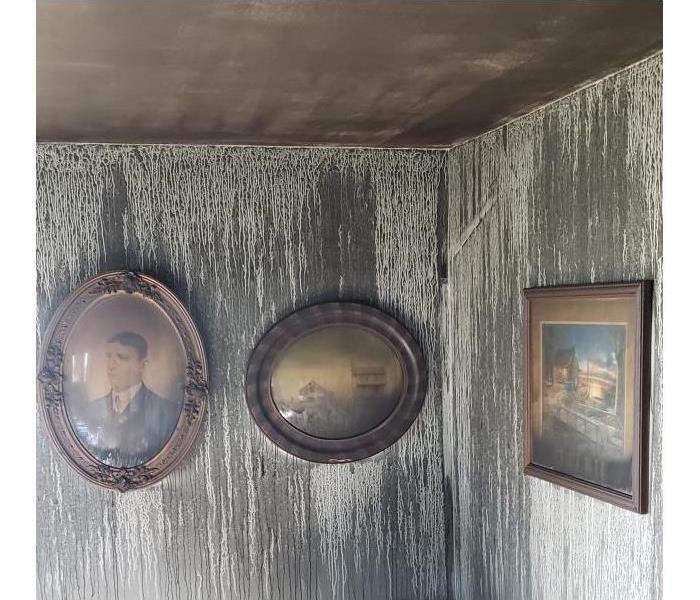 fire damage
fire damage
SERVPRO of Carroll County has the specialized fire restoration training needed to restore your home to pre-fire condition. Every fire is different, and smoke and soot creates a unique type of damage.
Smoke and soot damage is created after a fire has been extinguished in a home or a business, soot residue settles into the property. Soot is a very fine, black powder substance (0.25 µm in size) which binds to walls and fabric.
Like soot, smoke damage can be problematic, and it can cause serious health damage. It will cause discoloration of walls and it will sink into all property contents, causing smoke odor to linger for long periods of time.
This is why it is extremely important to hire a professional fire mitigation company to restore the damage.
The type of smoke or soot damage will define how we clean and treat the affected areas, but our process has several steps. We are trained extensively on all types of soot or smoke damage and if you contact as quickly enough, we will be able to restore most items. We also use Personal Protective Equipment as per Health and Safety regulations.
Fires can happen at any time, day or night. The most important thing is quick response time that’s why SERVPRO of Carroll County is available 24 hours a day/7 days a week.
How to prevent a Dryer Fire
2/17/2020 (Permalink)
9 TIPS TO PREVENT DRYER FIRES
- Clean out the lint. “It starts with cleaning out the lint filter every time you use the dryer.” says John Hall, Ph.D., division director of fire Analysis & Research for the National Fire Protection Association. He also advises clearing out the vent pipe to reduce the chance of fire and to maintain the efficiency of the dryer.
- Install with care. Be sure to follow the manufacturer’s instructions when installing the vent pipe. Use a short, straight pipe that’s an adequate distance from the wall. By reducing the bends in the dryer vent pipe, it creates fewer opportunities for lint to gather. If you have to vent your dryer over a long distance, consider investing in a dryer vent fan. These automatic electric devices speed up airflow through the duct every time you turn on your dryer to keep things moving along. A dryer vent fan should be installed by a licensed electrician.
- Clear out combustibles. Move any flammables like cleaning supplies far away from your dryer. Also regularly sweep out dust in the areas around and underneath your dryer.
- Opt for a solid metal dryer duct. Research shows that flexible foil or plastic ducts can sag and lead to lint buildup at low points. Metal ducts of any variety don’t sag, and they’re more likely to contain any fires that would start.
- Read tags. If the care label reads tumble dry low, don’t turn the dryer up to high. Also use caution with certain items like bath mats, padded bras and bibs—they may contain rubber that shouldn’t be exposed to hot temperatures.
- Exercise extra caution with flammable liquids. Wash clothing stained with volatile chemicals more than once—and definitely opt to line dry over machine dry.
- Use your clothes to diagnose problems. Clothes that no longer feel dry or that are extra hot to the touch after a normal dry cycle are a telltale sign that something’s wrong. Before doing the next load, check for a plugged vent and clean out any lint.
- Don’t dry and dash. Turn off your dryer if you need to step out during the laundry cycle.
9.Give the outdoor vent a peek. Make sure that the outdoor vent flap isn’t covered by snow or debris.
How to put out a kitchen fire
2/28/2019 (Permalink)
When a fire starts in the kitchen, you need to act fast to keep the fire from getting out of control. But how you act depends on what kind of fire you have and where it is. Follow these instructions for putting out kitchen fires:
If you have a fire in the oven or the microwave, close the door or keep it closed, and turn off the oven. Don’t open the door! The lack of oxygen will suffocate the flames.If your oven continues to smoke like a fire is still going on in there, call the fire department.If you have a fire in a cooking pan, use an oven mitt to clap on the lid, then move the pan off the burner, and turn off the stove. The lack of oxygen will stop the flames in a pot.
If you can’t safely put the lid on a flaming pan or you don’t have a lid for the pan, use your fire extinguisher. Aim at the base of the fire — not the flames.Never use water to put out grease fires! Water repels grease and can spread the fire by splattering the grease. Instead, try one of these methods:
If the fire is small, cover the pan with a lid and turn off the burner.Throw lots of baking soda or salt on it. Never use flour, which can explode or make the fire worse. Smother the fire with a wet towel or other large wet cloth.
Use a fire extinguisher. Don’t swat at a fire with a towel, apron, or other clothing. You’re likely to fan the flames and spread the fire.If the fire is spreading and you can’t control it, get everyone out of the house and call 911! Make sure everybody in your family knows how to get out of the house safely in case of a fire. Practice your fire escape route.
Are wood burning stoves safe?
2/1/2019 (Permalink)
The chimney for a wood burning stoves must be masonry or UL-listed, and factory built. Never, under any circumstances, should an unlined, single brick chimney be used for a wood stove. Single brick chimneys are prone to failure, which may allow potentially dangerous situations to develop.
There are lots older homes that have unlined chimneys constructed of double brick. These may be used for a wood stove after carefully checking for cracked mortar or loose or missing brick. Metal sleeves that are listed by the Underwriters Laboratory may be used as chimney lines if they were designed for such use.
Factory built, metal chimneys must never be used with a coal stove, as the corrosive flue gases produced by a coal fire will cause a rapid failure of the chimney. Metal chimneys should be completely disassembled after a chimney fire and checked for damage. Discoloration of the exterior indicates a possible breakdown of the insulating material. Any questionable section should be replaced.
A wood burning stove should never be connected to a wood stove flue which vents an oil burner. Deadly, unburned vapors from the oil burner could back up into the stove and the room where it is located.If your home came with an existing wood burning stove, you should have it serviced and inspected before use.
Venting the stove is the most important part of the wood-burning system. 90% of all stove-related fires start within the venting system. A venting system is not a chimney – it consists of lengths of 24-gauge or heavier, insulated stovepipe which connects the stove to an approved chimney.
Stovepipe clearance is extremely important. It must never pass through an interior wall, floor, or ceiling. Where possible, the insulated stovepipe must go directly into a lined masonry or UL-listed, factory-built chimney. If stovepipe must pass through an exterior wall to reach the chimney, maintain an 18-inch minimum clearance to all combustibles. Consult fire codes and use metal thimbles designed for this purpose.
Use proper fuel
Hardwoods, such as maple, beech, ash, hickory, or oak, are the best fuel for a wood burning stove. Wood should be cut, split and air dried for at least a year before burning. Well-seasoned hardwood will show cracks in the ends. Wood will dry faster and remain dry and protected from the elements if stored in a shed or under a tarp.
Regular cleaning
Use a wire brush to clean your stovepipe and chimney at least once a year. Also, occasionally use controlled high-temperature fires in the stove or furnace. Salt-based chemical cleaners are not very affective. Never use heavy items such as chains, bricks or a brush on the end of a rope, because they could seriously damage the interior chimney lining.
Avoid creosote buildup
Creosote is a highly combustible fuel that burns intensely. A slow-burning fire such as those found in a modern, airtight stove damped way down, produces a flue temperature in the 100-200 degree Fahrenheit range. These comparatively low temperatures do not sufficiently carry all of the unburned, combustible gases into the atmosphere. Instead, they condense along the walls of the stovepipe and the chimney as creosote. Creosote may take 3 forms:
- A sticky liquid that will run down the chimney and stove pipe where it will be burned
- A flaky, black deposit which is easily removed by brushing
- A hard, glazed tar which is almost impossible to remove, except by a certified professional chimney sweep
Tips for building a fire
- Season wood outdoors through the hot, dry summer for at least 6 months before burning it. Properly seasoned wood is darker, has cracks in the end grain, and sounds hollow when smacked against another piece of wood.
- Store wood outdoors, stacked neatly off the ground with the top covered.
- Start fires with clean newspaper and dry kindling.
- Burn hot, bright fires. But use smaller fires in milder weather.
- Let the fire burn down to coals, then rake the coals toward the air inlet (and wood stove door), creating a mound. Do not spread the coals flat.
- Reload your wood stove by adding at least three pieces of wood each time, on and behind the mound of hot coals. Avoid adding one log at a time.
- Regularly remove ashes from the wood stove into a metal container with a cover, and store outdoors.





 24/7 Emergency Service
24/7 Emergency Service
